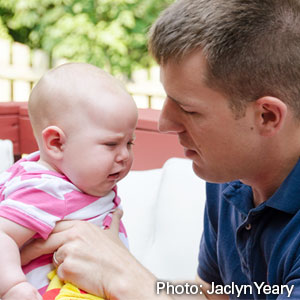By Julia Yeary, LCSW, ACSW, IMH-E®
I wish I had Babies on the Homefront when I was a home visitor. I don’t know how many times a parent would bring up something their child was doing and I would promise, “Next time I will bring you some information on that.” With Babies on the Homefront, most of the information needed can be found right at your fingertips.
Let’s say a parent tells you that their child is biting. You simply scroll through the Tips and Strategies library under “Challenging Behaviors” and find “When I hit or bite.” Boom! There is a quick paragraph the parent can read, then we can discuss what it says together.
I may be saying, “sometimes I’m angry,” or “I have so many feelings inside and no words for them that I lose control.” What you can do to support me is stop me firmly and gently. Tell me, “Its not OK to hit or bite.” Remind me it hurts. Never bite me back! Show me what I can do when I get angry or frustrated. Help me to name my feelings. Remember, I will need lots of help and time to learn self-control. Another thing to remember is that how you are feeling will affect how I am feeling. The calmer you are, the easier it will be for me to be calm.
The thing I like about this is I don’t have to lecture. I can have the parent read this short paragraph, then we can discuss how they feel about what they are reading. I think it gives parents more freedom to be real in their response. We can talk about why these discussions might be hard, and really think about what their child’s behavior is saying. It teaches parents to try and take their child’s point of view.
When a parent downloads the Babies on the Homefront app, I can suggest they click on the “More Info” button to find even more information on what we’re discussing. They can continue to explore different topics and share with me the badges they’ve earned when I return for my next visit.
I appreciate the section in Tips and Strategies that gives parents ideas for interacting with their child. I can choose one and we can try it out during a home visit. All the activities promote either parent-child connections or developing self-regulation. These are activities parents can do with things they have in their home already. For example, “Kitchen Band,” where a parent has their child join them in making noises with the kitchen equipment. We can turn a rubber bowl and a wooden spoon into a drum, or two pot lids into cymbals. There are lots of ideas, even ones a deployed parent can use to keep their connection strong when they are away from their child.
I am always trying to help parents think about how they can support their child’s rapid development. Babies on the Homefront has “Help me Grow” tips that not only help parents know what their baby can do, but also gives ideas on how they can do simple things to support baby’s next developmental milestones. All the tips and strategies can be filtered by a child’s age and can be set to at home, leaving soon, deployed, home again, or veteran. That helps me (and parents) find information in the app that is most meaningful.
Babies on the Homefront was designed for caregivers of military-connected children birth to 3, but it also is a powerful tool for professionals like me. Whether you are a home visitor, an early interventionist, a mental health clinician, or a family support specialist—check out Babies on the Homefront. It’s a tool that you will be reaching for everyday with families and recommending again and again.
Babies on the Homefront was developed by ZERO TO THREE. It’s free in both English and Spanish, and is available in both Apple and Google Play stores. Learn more at www.babiesonthehomefront.org.



